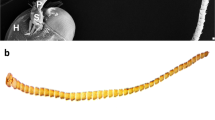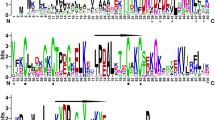Abstract
Four recombinant odorant-binding proteins of Bombyx mori, pheromone-binding protein (PBP), general odorant-binding protein 1 (GOBP1), general odorant-binding protein 2 (GOBP2) and antennal binding protein X (ABPX), were expressed in E. coli and used to raise polyclonal antisera. Immunoblots of antennal homogenates showed that these antisera were specific. In Western blot analysis and immunocytochemical labelling experiments, the sera against recombinant PBP and GOBP2 of B. mori gave identical results as sera against native PBP and GOBP2 of Antheraea polyphemus, respectively, thus confirming earlier results obtained with the latter. Labelling consecutive cross sections of various sensillum types with all four antisera revealed different labelling patterns in male and female sensilla (s.) trichodea and s. basiconica. Long s. trichodea in males and females represented uniform labelling types, whereas for short s. trichodea, s. intermedia, and s. basiconica a great variety of labelling patterns was observed, some being more common than others. Long s. trichodea, which in males are uniformly tuned to the pheromone components bombykol and bombykal, all strongly expressed PBP; labelling with antisera against the other three odorant-binding proteins hardly was above background, only in some hairs GOBP1 was expressed somewhat more strongly. Long s. trichodea of females, which respond specifically to linalool and benzoic acid, showed a different labelling pattern. Here, we observed strong labelling with antibodies against GOBP2 and medium labelling with anti-GOBP1, sometimes with anti-ABPX. S. basiconica in both sexes most commonly co-expressed GOBP1 and GOBP2, but other patterns were occasionally found, with some of them showing PBP expression, also in females. The great variety of labelling types in short s. trichodea, s. intermedia, and s. basiconica suggests a similar variety of functional subtypes as observed in plant odour-sensitive sensilla of other moth species.
Similar content being viewed by others
References
ANDERSON, P. HANSSON, B. S.& LÖFQUIST, J.(1995) Plant-odour-specific receptor neurons on the antennae of female and male Spodoptera littoralis. Physiological Entomology 20, 189–198.
BATTEIGER, B., NEWHALL, W. J. & JONES, R. B.(1982) The use of tween 20 as a blockingagent in the immunological detection of proteins transferred to nitrocellulose membranes. Journal of Immunological Methods 55, 297–307.
BICHÃO, H., BORG-KARLSON, A.-K., ARAÚJO, J.& MUSTAPARTA, H. (2005) Five types of olfactory receptor neurons in the strawberryblossom weevil Anthonomus rubi: selective responses toinducible host-plant volatiles. Chemical Senses 30, 153–170.
Boeckh, J., Kaissling, K.-E. & Schneider, D. (1965) Insectolfactory receptors. Cold Spring Harbor Symposia onquantitative Biology 30, 263–280.
Butenandt, A., Beckmann, R., Stamm, D.& Hecker, E.(1959) Über den Sexuallockstoff des Seidenspinners Bombyx mori. Reindarstellung und Konstitution. Zeitschrift für Naturforschung 14b, 283–284.
Clyne, P., Grant, A., O'Connell, R. & Carlson, J. R.(1997)Odorant response of individual sensilla on the Drosophila antenna. Invertebrate Neuroscience 3, 127–135.
Danscher, G. (1981) Localization of gold in biological tissue:A photochemical method for light and electronmicroscopy. Histochemistry 71, 81–88.
Dobritsa, A. A., van der Goes van Naters, W., Warr, C. G.,Steinbrecht, R. A. & Carlson, J. R. (2003) Integrating themolecular and cellular basis of odor coding in the Drosophila antenna. Neuron 37, 827–841.
Fujii, S. & Amrein, H. (2002) Genes expressed in the Drosophila head reveal a role for fat cells in sex-specificphysiology. EMBO Journal 21, 5353–5363.
Galindo, K. & Smith, D. P. (2001) A large family of divergent Drosophila odorant-binding proteins expressed in gustatoryand olfactory sensilla. Genetics 159, 1059–1072.
Hallem, E. A., Ho, M. G. & Carlson, J. R. (2004) The molecularbasis of odor coding in the Drosophila antenna. Cell 117, 965–979.
Heinbockel, T. & Kaissling, K.- E. (1996) Variability ofolfactory receptor neuron responses of female silk moths (Bombyx mori L.) to benzoic acid and (±)-linalool. Journal of Insect Physiology 42, 565–578.
Hekmat-Scafe, D. S., Steinbrecht, R. A. & Carlson, J. R. (1997) Coexpression of two odorant-binding protein homologs inDrosophila: implications for olfactory coding. Journalof Neuroscience 17, 1616–1624.
Hekmat-Scafe, D. S., Scafe, C. R., McKinney, A. J. & Tanouye, M. A. (2002) Genome-wide analysis of the odorant-bindingprotein gene family in Drosophila melanogaster. Genome Research 12, 1357–1369.
Jonasson, P., Nilsson, J., Samuelsson, E., Moks, T., St/AA hl, S.Å Uhl/e n, M. (1996) Single-step trypsin cleavage of afusion protein to obtain human insulin and its C peptide. European Journal of Biochemistry 236, 656–661.
Kaissling, K.-E. (2001) Olfactory perireceptor and receptorevents in moths: a kinetic model. Chemical Senses 26, 125–150.
Kaissling, K.-E. & Priesner, E. (1970) Die Riechschwelledes Seidenspinners. Naturwissenschaften 57, 23–28.
Kaissling, K.-E., Kasang, G., Bestmann, H. J., Stransky, W.& Vostrowsky, O. (1978) A new pheromone of the silkworm moth Bombyx morio: sensory pathway and behavioral effect. Naturwissenschaften 65, 382–384.
Krieger, J., Nickisch-Rosenegk, E., Mameli, M., Pelosi, P. & Breer, H. (1996) Binding proteins from the antennae of Bombyx mori. Insect Biochemistry and Molecular Biology 26, 297–307.
Krieger, J., Grosse-Wilde, E., Gohl, T. & Breer, H. (2005) Candidate pheromone receptors of the silkmoth B. mori. European Journal of Neuroscience 21, 2167–2176.
Kyhse-Andersen, J. (1984) Electroblotting of multiple gels:a simple apparatus without buffer tank for rapid transfer ofproteins from polyacrylamide to nitrocellulose. Journal of Biochemical and Biophysical Methods 10, 203–209.
Laemmli, U. K. (1970) Cleavage of structural proteins duringthe assembly of the head of bacteriophage T4. Nature 227, 680–685.
Maida, R., Steinbrecht, R. A., Ziegelberger, G. & Pelosi, P. (1993) The pheromone binding protein of Bombyx mori:purification, characterization and immunocytochemicallocalization. Insect Biochemistry and Molecular Biology 23, 243–253.
Maida, R., Proebstl, T. & Laue, M. (1997) Heterogeneity ofodorant-binding proteins in the antenna of Bombyx mori. Chemical Senses 22, 503–515.
Maida, R., Mameli, M., Krieger, J., Breer, H., Ziegelberger, G. & Steinbrecht, R. A. (1999) Complex expression pattern ofodorant-binding proteins in Bombyx mori. In Göttingen Neurobiology Report 1999 (edited by Elsner, N. &Eysel, U.), p. 359. Stuttgart: Thieme.
Maida, R., Krieger, J., Gebauer, T., Lange, U. & Ziegelberger, G. (2000) Three pheromone-binding proteins in olfactory sensillaof the two silkmoth species Antheraea polyphemus and Antheraea pernyi. European Journal of Biochemistry 267, 2899–2908.
Maida, R., Ziegelberger, G. & Kaissling, K.- E. (2003) Ligand binding to six recombinant pheromone-binding proteins ofAntheraea polyphemus and Antheraea pernyi. Journal of Comparative Physiology B 173, 565– 573.
Marshall, A. T. & Kent, M. (1991) A device forfreeze-substituting a large number of samples under controlledconditions. Journal of Microscopy 162, 335–340.
Nakagawa, T., Sakurai, T., Nishioka, T. & Touhara, K. (2005)Insect sex-pheromone signals mediated by specific combinations ofolfactory receptors. Science 307, 1638–1642.
Newman, G. R., Jasani, B. & Williams, E. D. (1983) A simplepost-embedding system for the rapid demonstration of tissueantigens under the electron microscope. Histochemical Journal 15, 543–555.
Nilsson, J., Nilsson, P., Williams, Y., Pettersson, L., UhlÉn, M. Uhlén Nygren, P. (1994) Competitive elution of protein A fusions proteins allows specific recovery under mild conditions. European Journal of Biochemistry 224, 103–108.
Park, S.-K., Shanbhag, S. R., Wang, Q., Hasan, G., Steinbrecht, R. A. & Pikielny, C. W. (2000) Different expressionpatterns of two putative odorant-binding proteins in the olfactoryorgans of Drosophila melanogaster have differentimplications for their functions. Cell and Tissue Research 300, 181–192.
Pophof, B. (2002) Moth pheromone binding proteins contribute tothe excitation of olfactory receptor cells. Naturwissenschaften 89, 515–518.
Pophof, B. (2004) Pheromone-binding proteins contribute to theactivation of olfactory receptor neurons in the silkmoths Antheraea polyphemus and Bombyx mori. Chemical Senses 29, 117–125.
Pophof, B., stange, G. & abrell, L. (2005) Volatile organic compounds as signals in aplant-herbivore system: Electrophysiological responses inolfactory sensilla of the moth Cactoblastis cactorum. Chemical Senses 30, 51–68.
Røstelien, T., Stranden, M., Borg-Karlson, A.-K. & Mustaparta, H. (2005) Olfactory receptor neurons in twoheliothine moth species responding selectively to aliphatic greenleaf volatiles, aromatic compounds, monoterpenes andsesquiterpenes of plant origin. Chemical Senses 30, 443–461.
Sakurai, T., Nakagawa, T., Mitsuno, H., Mori, H., Endo, Y.,Tanue, S., Yasukochi, Y., Touhara, K. & Nishioka, T. (2004)Identification and functional characterization of a sex pheromonereceptor in the silk moth Bombyx mori. Proceedings ofthe National Academy of Sciences 101, 16653– 16658.
Sandler, B. H., Nikonova, L., Leal, W. S. & Clardy, J. (2000) Sexual attraction in the silkworm moth: structure of thepheromone-binding-protein$bombykol complex. Chemistry & Biology 7, 143–151.
Schneider, D. (1957) Elektrophysiologische Untersuchungen von Chemo- und Mechanorezeptoren der Antenne des Seidenspinners Bombyx mori L. Zeitschrift für Vergleichende Physiologie 40, 8–41.
Schneider, D. & Kaißling, K.-E. (1957) Der Bau der Antenne des Seidenspinners Bombyx mori L. II. Sensillen,cuticulare Bildungen und innerer Bau. Zoologische Jahrbücher, Anatomie und Ontogenie 76, 223–250.
Shanbhag, S. R., Müller, B. & Steinbrecht, R. A. (1999)Atlas of olfactory organs of Drosophila melanogaster. 1.Types, external organization, innervation and distribution ofolfactory sensilla. International Journal of Insect Morphology & Embryology 28, 377– 397.
Shanbhag, S. R., Hekmat-Scafe, D., Kim, M.-S., Park, S.-K., Carlson, J. R., Pikielny, C., Smith, D. P. & Steinbrecht, R.A. (2001a) Expression mosaic of odorant-binding proteins in Drosophila olfactory organs. Microscopy Research and Technique 55, 297–306.
Shanbhag, S. R., Park, S.-K., Pikielny, C. W. & Steinbrecht, R. A. (2001b) Gustatory organs of Drosophila melanogaster: Fine structure and expression of the putative odorant-bindingprotein PBPRP2. Cell and Tissue Research 304, 423–437.
Shanbhag, S. R., Smith, D. P. & Steinbrecht, R. A. (2005) Three odorant-binding proteins are co-expressed in sensillatrichodea of Drosophila melanogaster. Arthropod Structure & Development 34, 153–165.
Steinbrecht, R. A. (1970) Zur Morphometrie der Antenne des Seidenspinners, Bombyx mori L: Zahl und Verteilung der Riechsensillen (Insecta, Lepidoptera). Zeitschrift für Morphologie der Tiere 68, 93–126.
Steinbrecht, R. A. (1973) Der Feinbau olfaktorischer Sensillendes Seidenspinners (Insecta, Lepidoptera): Rezeptorfortsätzeund reizleitender Apparat. Zeitschrift für Zellforschungund Mikroskopische Anatomie 139, 533–565.
Steinbrecht, R. A. (1993) Freeze-substitution for morphologicaland immunocytochemical studies in insects. Microscopy Research and Technique 24, 488–504.
Steinbrecht, R. A. (1996) Are odorant-binding proteins involvedin odorant discrimination? Chemical Senses 21, 719–727.
Steinbrecht, R. A., Ozaki, M. & Ziegelberger, G. (1992) Immunocytochemical localization of pheromone-binding protein inmoth antennae. Cell and Tissue Research 270, 287–302.
Steinbrecht, R. A., Laue, M. & Ziegelberger, G. (1995) Immunolocalization of pheromone-binding protein and generalodorant-binding protein in olfactory sensilla of the silk moths Antheraea and Bombyx. Cell and Tissue Research 282, 203–217.
Todd, J. L. & Baker, T. C. (1993) Response of single antennalneurons of female cabbage loopers to behaviorally activeattractants. Naturwissenschaften 80, 183–186.
Van den Berg, M. J. & Ziegelberger, G. (1991) On the functionof the pheromone binding protein in the olfactory hairs of Antheraea polyphemus. Journal of Insect Physiology 37, 79–85.
Vogt, R. G. (2003) Biochemical diversity of odor detection:OBPs, ODEs and SNMPs. In Insect pheromone biochemistry andmolecular biology. The biosynthesis and detection of pheromonesand plant volatiles (edited by Blomquist, G. & Vogt, R.), pp.391–445. Amsterdam: Elsevier Academic Press.
Vogt, R. G. & Riddiford, L. M. (1981) Pheromone binding andinactivation by moth antennae. Nature 293, 161–163.
Xu, P. X., Atkinson, R., Jones, D. N. M. & Smith, D. P. (2005)Drosophila OBP LUSH is required for activity ofpheromone-sensitive neurons. Neuron 45, 193–200.
Zhang, S.- G., Maida, R. & Steinbrecht, R. A. (2001)Immunolocalization of odorant-binding proteins in noctuid moths(Insecta, Lepidoptera). Chemical Senses 26, 885–896.
Author information
Authors and Affiliations
Corresponding author
Additional information
These Authors have contributed equally.
Rights and permissions
About this article
Cite this article
Maida, R., Mameli, M., Müller, B. et al. The expression pattern of four odorant-binding proteins in male and female silk moths, Bombyx mori . J Neurocytol 34, 149–163 (2005). https://doi.org/10.1007/s11068-005-5054-8
Received:
Revised:
Accepted:
Issue Date:
DOI: https://doi.org/10.1007/s11068-005-5054-8




